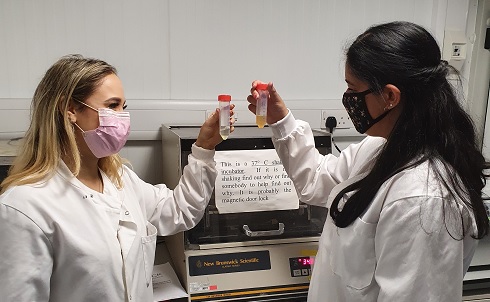My Lab Unlocked: Dr Antonia Sagona MRSB

Dr Antonia Sagona MRSB on how the Sagona lab studies and modifies phages to help diagnose and treat infections
20th August 2021
In my lab we work on genetically modified bacteriophages with properties that allow them to be used safely in a variety of applications. To understand the molecular mechanisms of phage therapy, for example how bacteriophages interact with their host bacteria and human cells, we have genetically modified phages to make them fluorescent, and we observe the interaction between phage, bacteria and human cells using microscopy and other methods.
We also genetically modify bacteriophages to be used as diagnostics for infection. For this, we have constructed bioluminescent bacteriophages and we collaborate with different disciplines, including clinicians, chemists, vets and engineers to develop and test our diagnostic tests.
Alongside this, we aim to understand the development of resistance and the evolution of the host bacteria that occurs during phage infection. For this, we collaborate with statisticians, physicists and bioinformaticians.
The big challenge when it comes to phage therapy, especially in UK, is the regulatory barriers that are involved, particularly when it comes to genetically modified bacteriophages.
The frontiers in this area of research are understanding how exactly bacteriophages interact with human cells. I think this is a really interesting field that more and more labs in the world are interested in. We would like to investigate further the immune response that the body presents when phage therapy is administered, and the resistance to phages that results from phage therapy. Another interesting area is the study of the interplay between phages and antibiotics or other antibacterial agents. These are some very crucial areas that can help us further refine phage therapy.
I think that my lab is particularly interesting because of our combination of approaches. We are working with microbiology and phage biology methods, but in almost all the projects we have a human cell biology and confocal microscopy approach, due to my background on these two areas.
So, even though we do microbiology, we approach it more from the cellular and molecular mechanistic aspect. Along with that we also use synthetic biology methods to genetically modify bacteriophages. We are interested in both basic and applied research and we also have great interest in collaboration with industry. The combination of these characteristics is what makes us interesting (I hope)! We are generally very open to collaborations and are interested in collaborating more with immunologists, clinicians, chemists and industry.
 Dr Sagona's lab combines multiple approaches to research
Dr Sagona's lab combines multiple approaches to researchDr Antonia Sagona MRSB is an Associate Professor of molecular and cellular mechanisms of phage therapy, in the School of Life Sciences, University of Warwick.


